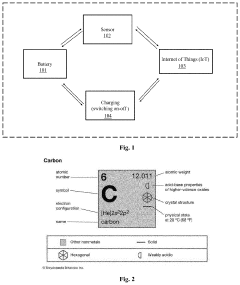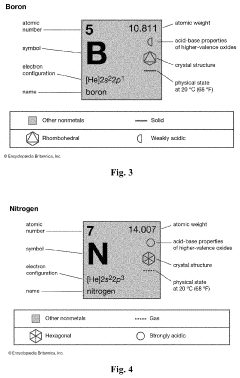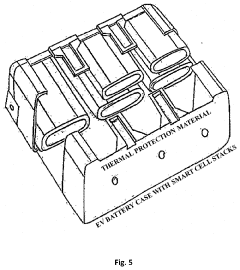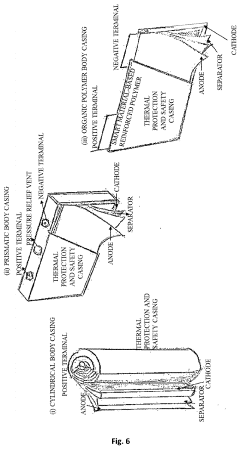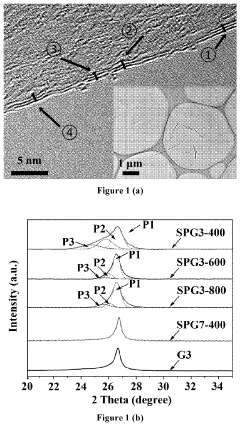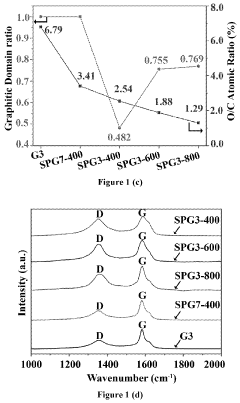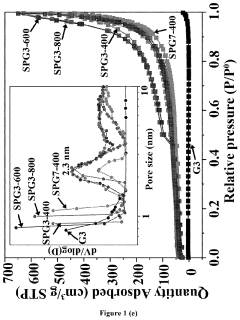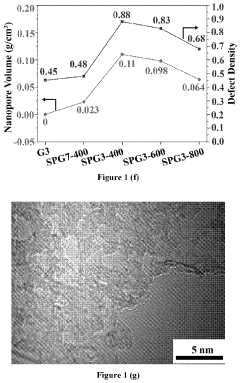How to Leverage Graphene Battery for Sustainable Transport?
AUG 6, 202510 MIN READ
Generate Your Research Report Instantly with AI Agent
Patsnap Eureka helps you evaluate technical feasibility & market potential.
Graphene Battery Evolution and Objectives
Graphene batteries represent a revolutionary advancement in energy storage technology, with the potential to transform sustainable transportation. The evolution of graphene batteries can be traced back to the discovery of graphene in 2004, which sparked intense research into its applications across various fields, including energy storage.
The primary objective of graphene battery development for sustainable transport is to create a high-performance, long-lasting, and environmentally friendly energy storage solution. This technology aims to overcome the limitations of traditional lithium-ion batteries, such as slow charging times, limited energy density, and degradation over time.
In the early stages of graphene battery research, scientists focused on understanding the material's unique properties, including its exceptional electrical conductivity, mechanical strength, and large surface area. These characteristics make graphene an ideal candidate for enhancing battery performance.
As research progressed, the focus shifted towards integrating graphene into existing battery technologies. One of the key milestones was the development of graphene-enhanced electrodes, which significantly improved the charging speed and energy density of batteries. This breakthrough paved the way for more practical applications in the transportation sector.
The evolution of graphene batteries has been marked by continuous improvements in manufacturing processes and material engineering. Researchers have explored various forms of graphene, such as graphene oxide, reduced graphene oxide, and graphene nanoplatelets, to optimize battery performance for different applications.
In recent years, the objectives of graphene battery development have expanded to address specific challenges in sustainable transport. These include increasing the driving range of electric vehicles, reducing charging times to levels comparable with refueling conventional vehicles, and enhancing the overall lifespan of batteries to reduce waste and improve sustainability.
Another critical objective is to develop graphene batteries that are safer and more stable than traditional lithium-ion batteries. This is particularly important for the transportation sector, where safety is paramount. Researchers are working on graphene-based solutions that minimize the risk of thermal runaway and improve the overall safety profile of energy storage systems.
The evolution of graphene batteries also encompasses efforts to make the technology more cost-effective and scalable for mass production. This is crucial for widespread adoption in the automotive industry and other transportation sectors. As manufacturing processes improve and economies of scale are realized, the cost of graphene batteries is expected to decrease, making them more competitive with existing technologies.
Looking ahead, the objectives for graphene battery development in sustainable transport include further increasing energy density to extend vehicle range, improving fast-charging capabilities to reduce downtime, and enhancing the integration of these batteries with renewable energy sources for a more sustainable transportation ecosystem.
The primary objective of graphene battery development for sustainable transport is to create a high-performance, long-lasting, and environmentally friendly energy storage solution. This technology aims to overcome the limitations of traditional lithium-ion batteries, such as slow charging times, limited energy density, and degradation over time.
In the early stages of graphene battery research, scientists focused on understanding the material's unique properties, including its exceptional electrical conductivity, mechanical strength, and large surface area. These characteristics make graphene an ideal candidate for enhancing battery performance.
As research progressed, the focus shifted towards integrating graphene into existing battery technologies. One of the key milestones was the development of graphene-enhanced electrodes, which significantly improved the charging speed and energy density of batteries. This breakthrough paved the way for more practical applications in the transportation sector.
The evolution of graphene batteries has been marked by continuous improvements in manufacturing processes and material engineering. Researchers have explored various forms of graphene, such as graphene oxide, reduced graphene oxide, and graphene nanoplatelets, to optimize battery performance for different applications.
In recent years, the objectives of graphene battery development have expanded to address specific challenges in sustainable transport. These include increasing the driving range of electric vehicles, reducing charging times to levels comparable with refueling conventional vehicles, and enhancing the overall lifespan of batteries to reduce waste and improve sustainability.
Another critical objective is to develop graphene batteries that are safer and more stable than traditional lithium-ion batteries. This is particularly important for the transportation sector, where safety is paramount. Researchers are working on graphene-based solutions that minimize the risk of thermal runaway and improve the overall safety profile of energy storage systems.
The evolution of graphene batteries also encompasses efforts to make the technology more cost-effective and scalable for mass production. This is crucial for widespread adoption in the automotive industry and other transportation sectors. As manufacturing processes improve and economies of scale are realized, the cost of graphene batteries is expected to decrease, making them more competitive with existing technologies.
Looking ahead, the objectives for graphene battery development in sustainable transport include further increasing energy density to extend vehicle range, improving fast-charging capabilities to reduce downtime, and enhancing the integration of these batteries with renewable energy sources for a more sustainable transportation ecosystem.
Market Demand for Sustainable Transport Solutions
The global demand for sustainable transport solutions has been steadily increasing in recent years, driven by growing environmental concerns, stricter regulations, and a shift in consumer preferences towards eco-friendly alternatives. This trend has created a significant market opportunity for innovative technologies like graphene batteries, which offer potential solutions to many of the challenges faced by traditional transportation systems.
In the automotive sector, the demand for electric vehicles (EVs) has been surging, with major markets such as China, Europe, and North America leading the charge. This growth is fueled by government incentives, improved charging infrastructure, and advancements in battery technology. Graphene batteries, with their potential for higher energy density, faster charging times, and longer lifespan, could address many of the current limitations of lithium-ion batteries used in EVs.
Public transportation systems are also seeking more sustainable options to reduce their carbon footprint and operational costs. Many cities worldwide are investing in electric buses and trains, creating a substantial market for advanced battery technologies. Graphene batteries could offer extended range and reduced charging times, making them particularly attractive for high-frequency urban transit systems.
The aviation industry, while currently relying heavily on fossil fuels, is actively exploring sustainable alternatives. Electric and hybrid-electric aircraft are being developed, with graphene batteries potentially playing a crucial role in overcoming the weight and energy density challenges that have hindered progress in this sector.
In the maritime sector, there is growing interest in electrification, particularly for short-sea shipping and inland waterways. Graphene batteries could provide the high power output and energy storage capacity needed for larger vessels, opening up new possibilities for sustainable shipping.
The micromobility market, including e-bikes and e-scooters, has experienced rapid growth in urban areas. These lightweight electric vehicles require compact, efficient, and durable power sources, making them ideal candidates for graphene battery applications.
As cities worldwide strive to become smarter and more sustainable, the demand for energy storage solutions in transportation infrastructure is also increasing. Graphene batteries could be integrated into charging stations, traffic management systems, and other smart city applications, further expanding their market potential.
The market demand for sustainable transport solutions extends beyond the vehicles themselves to the entire ecosystem of supporting technologies and services. This includes battery management systems, charging infrastructure, and recycling facilities, all of which could benefit from the unique properties of graphene batteries.
In the automotive sector, the demand for electric vehicles (EVs) has been surging, with major markets such as China, Europe, and North America leading the charge. This growth is fueled by government incentives, improved charging infrastructure, and advancements in battery technology. Graphene batteries, with their potential for higher energy density, faster charging times, and longer lifespan, could address many of the current limitations of lithium-ion batteries used in EVs.
Public transportation systems are also seeking more sustainable options to reduce their carbon footprint and operational costs. Many cities worldwide are investing in electric buses and trains, creating a substantial market for advanced battery technologies. Graphene batteries could offer extended range and reduced charging times, making them particularly attractive for high-frequency urban transit systems.
The aviation industry, while currently relying heavily on fossil fuels, is actively exploring sustainable alternatives. Electric and hybrid-electric aircraft are being developed, with graphene batteries potentially playing a crucial role in overcoming the weight and energy density challenges that have hindered progress in this sector.
In the maritime sector, there is growing interest in electrification, particularly for short-sea shipping and inland waterways. Graphene batteries could provide the high power output and energy storage capacity needed for larger vessels, opening up new possibilities for sustainable shipping.
The micromobility market, including e-bikes and e-scooters, has experienced rapid growth in urban areas. These lightweight electric vehicles require compact, efficient, and durable power sources, making them ideal candidates for graphene battery applications.
As cities worldwide strive to become smarter and more sustainable, the demand for energy storage solutions in transportation infrastructure is also increasing. Graphene batteries could be integrated into charging stations, traffic management systems, and other smart city applications, further expanding their market potential.
The market demand for sustainable transport solutions extends beyond the vehicles themselves to the entire ecosystem of supporting technologies and services. This includes battery management systems, charging infrastructure, and recycling facilities, all of which could benefit from the unique properties of graphene batteries.
Graphene Battery Technology: Current Status and Challenges
Graphene battery technology has emerged as a promising solution for sustainable transport, offering significant advantages over traditional lithium-ion batteries. The current status of graphene battery technology is characterized by rapid advancements in research and development, with several key challenges still to be addressed.
One of the primary advantages of graphene batteries is their potential for high energy density and fast charging capabilities. Researchers have demonstrated that graphene-enhanced electrodes can significantly increase the surface area for energy storage, potentially doubling or even tripling the energy density of conventional lithium-ion batteries. This improvement in energy density could lead to electric vehicles with substantially increased range, addressing one of the main concerns of consumers regarding electric transportation.
Another notable advancement is the enhanced charging speed of graphene batteries. Some prototypes have shown the ability to charge up to five times faster than traditional lithium-ion batteries, potentially reducing charging times from hours to minutes. This breakthrough could revolutionize the electric vehicle industry by making long-distance travel more convenient and reducing the need for extensive charging infrastructure.
Despite these promising developments, several challenges remain in the commercialization of graphene battery technology. One significant hurdle is the high production cost of graphene materials. While graphene itself is abundant, the processes required to produce high-quality graphene sheets suitable for battery applications are currently expensive and difficult to scale. Researchers are actively working on developing more cost-effective production methods to make graphene batteries economically viable for mass production.
Another challenge lies in the integration of graphene into existing battery manufacturing processes. The unique properties of graphene require modifications to traditional battery assembly techniques, and ensuring consistent quality and performance across large-scale production remains a significant technical challenge. Additionally, long-term stability and safety concerns need to be thoroughly addressed before graphene batteries can be widely adopted in the automotive industry.
Efforts to overcome these challenges are ongoing, with collaborations between academic institutions, research laboratories, and industry partners driving innovation in the field. Recent advancements in graphene synthesis techniques, such as chemical vapor deposition and electrochemical exfoliation, show promise in reducing production costs and improving scalability. Furthermore, novel electrode designs and electrolyte formulations are being explored to optimize the performance and stability of graphene-based batteries.
As the technology continues to mature, we can expect to see incremental improvements in energy density, charging speed, and overall performance of graphene batteries. The potential impact on sustainable transport is significant, with the promise of electric vehicles that can travel longer distances, charge faster, and potentially last longer than those powered by conventional batteries. However, it is important to note that widespread adoption will depend on successfully addressing the current challenges and demonstrating the long-term reliability and safety of graphene battery technology in real-world applications.
One of the primary advantages of graphene batteries is their potential for high energy density and fast charging capabilities. Researchers have demonstrated that graphene-enhanced electrodes can significantly increase the surface area for energy storage, potentially doubling or even tripling the energy density of conventional lithium-ion batteries. This improvement in energy density could lead to electric vehicles with substantially increased range, addressing one of the main concerns of consumers regarding electric transportation.
Another notable advancement is the enhanced charging speed of graphene batteries. Some prototypes have shown the ability to charge up to five times faster than traditional lithium-ion batteries, potentially reducing charging times from hours to minutes. This breakthrough could revolutionize the electric vehicle industry by making long-distance travel more convenient and reducing the need for extensive charging infrastructure.
Despite these promising developments, several challenges remain in the commercialization of graphene battery technology. One significant hurdle is the high production cost of graphene materials. While graphene itself is abundant, the processes required to produce high-quality graphene sheets suitable for battery applications are currently expensive and difficult to scale. Researchers are actively working on developing more cost-effective production methods to make graphene batteries economically viable for mass production.
Another challenge lies in the integration of graphene into existing battery manufacturing processes. The unique properties of graphene require modifications to traditional battery assembly techniques, and ensuring consistent quality and performance across large-scale production remains a significant technical challenge. Additionally, long-term stability and safety concerns need to be thoroughly addressed before graphene batteries can be widely adopted in the automotive industry.
Efforts to overcome these challenges are ongoing, with collaborations between academic institutions, research laboratories, and industry partners driving innovation in the field. Recent advancements in graphene synthesis techniques, such as chemical vapor deposition and electrochemical exfoliation, show promise in reducing production costs and improving scalability. Furthermore, novel electrode designs and electrolyte formulations are being explored to optimize the performance and stability of graphene-based batteries.
As the technology continues to mature, we can expect to see incremental improvements in energy density, charging speed, and overall performance of graphene batteries. The potential impact on sustainable transport is significant, with the promise of electric vehicles that can travel longer distances, charge faster, and potentially last longer than those powered by conventional batteries. However, it is important to note that widespread adoption will depend on successfully addressing the current challenges and demonstrating the long-term reliability and safety of graphene battery technology in real-world applications.
Existing Graphene Battery Solutions for Transport
01 Graphene-based electrode materials
Graphene is used as an electrode material in batteries due to its high conductivity and large surface area. This can improve the battery's capacity, charge/discharge rates, and overall performance. Various forms of graphene, such as graphene oxide or reduced graphene oxide, are incorporated into electrode structures to enhance energy storage capabilities.- Graphene-based electrode materials: Graphene is used as an electrode material in batteries due to its high conductivity and large surface area. This can enhance the battery's performance, including increased energy density and faster charging rates. Various forms of graphene, such as graphene oxide or reduced graphene oxide, are incorporated into electrode structures to improve overall battery efficiency.
- Graphene-enhanced electrolytes: Graphene is utilized to improve electrolyte performance in batteries. By incorporating graphene or its derivatives into the electrolyte, ionic conductivity can be increased, leading to better overall battery performance. This approach can also help in stabilizing the electrolyte and preventing unwanted side reactions.
- Graphene-based composite materials: Composite materials combining graphene with other substances are developed for battery applications. These composites can enhance various aspects of battery performance, such as capacity, cycling stability, and mechanical strength. Examples include graphene-metal oxide composites for cathodes or graphene-silicon composites for anodes.
- Graphene for thermal management: Graphene's excellent thermal conductivity is utilized for heat management in batteries. By incorporating graphene into battery components or as a heat-dissipating layer, the overall thermal performance of the battery can be improved. This can lead to enhanced safety and longer battery life by preventing overheating issues.
- Manufacturing processes for graphene batteries: Various manufacturing techniques are developed to produce graphene-based battery components efficiently and at scale. These processes focus on methods to integrate graphene into existing battery architectures or create entirely new graphene-based battery designs. Techniques may include chemical vapor deposition, solution processing, or 3D printing of graphene-based materials.
02 Graphene-enhanced electrolytes
Graphene or graphene derivatives are incorporated into battery electrolytes to improve ionic conductivity and stability. This can lead to better battery performance, increased safety, and longer cycle life. The unique properties of graphene allow for the development of solid-state or gel electrolytes with enhanced characteristics.Expand Specific Solutions03 Graphene-based composite materials
Composite materials combining graphene with other substances, such as metal oxides or polymers, are developed for use in battery components. These composites can enhance the mechanical and electrochemical properties of electrodes or separators, leading to improved battery performance and durability.Expand Specific Solutions04 Graphene manufacturing processes for battery applications
Specialized manufacturing processes are developed to produce graphene materials optimized for battery applications. These may include methods for creating specific graphene structures, functionalization techniques, or scalable production processes to enable commercial implementation of graphene-based battery technologies.Expand Specific Solutions05 Graphene-enabled flexible and wearable batteries
Graphene's unique properties are utilized to develop flexible and wearable battery technologies. These batteries can be integrated into various devices and applications, offering improved energy storage capabilities while maintaining flexibility and durability. The use of graphene enables the creation of thin, lightweight, and bendable battery structures.Expand Specific Solutions
Key Players in Graphene Battery Industry
The graphene battery market for sustainable transport is in an early growth stage, characterized by significant research and development efforts across academia and industry. While the market size is still relatively small, it shows promising potential due to graphene's superior properties for energy storage. The technology is progressing towards maturity, with key players like Northwestern University, University of Florida, and Harbin Institute of Technology leading academic research. Companies such as Semiconductor Energy Laboratory, SABIC Global Technologies, and Apple are actively developing commercial applications. Collaboration between research institutions and industry partners, exemplified by partnerships involving National Technology & Engineering Solutions of Sandia and China Petroleum & Chemical Corp., is accelerating the technology's advancement towards practical implementation in sustainable transportation solutions.
Apple, Inc.
Technical Solution: While primarily known for consumer electronics, Apple has been researching graphene-based battery technologies that could have applications in sustainable transport. Their approach focuses on using graphene as a heat spreader in battery packs to improve thermal management and charging speeds. Apple's patents describe a graphene layer that can be integrated into the battery structure to dissipate heat more efficiently, potentially allowing for faster charging and improved battery longevity [8]. This technology could be particularly beneficial for electric vehicles, where thermal management is crucial for battery performance and safety.
Strengths: Strong R&D capabilities, expertise in miniaturization and efficient power management. Weaknesses: Limited direct experience in automotive applications.
Volvo Personvagnar AB
Technical Solution: Volvo has been investigating graphene-enhanced batteries as part of their commitment to electrification and sustainability. Their approach involves incorporating graphene into battery electrodes to improve energy density and charging speeds. Volvo's research suggests that graphene-enhanced batteries could potentially increase the range of electric vehicles by up to 30% without increasing battery size or weight [6]. The company is also exploring the use of graphene in structural battery technology, where battery cells are integrated into the vehicle's body panels, potentially reducing overall vehicle weight and improving energy efficiency [7].
Strengths: Integration of battery technology with vehicle design, focus on sustainability. Weaknesses: Potential challenges in mass production and ensuring long-term reliability.
Core Innovations in Graphene Battery Technology
Systems, methods and apparatus for improving rechargeable energy storage devices and integrated circuits
PatentActiveUS20230092765A1
Innovation
- The development of a smart rechargeable energy storage device using pure organic carbon-based graphene in a solid-state configuration, with graphene sheets forming the anode and cathode electrodes and serving as a separator, enabling faster charging, longer cycle life, and enhanced energy density, while eliminating safety hazards through self-healing and safer materials.
Graphene processing technique
PatentPendingUS20240021820A1
Innovation
- A surfactant-assisted thermal reductive perforation process using poly(alkylene oxide) to generate surface-perforated graphene with in-plane mesopores, expanded interlayer lattice, and low oxygen content, facilitating AlCl4− ion storage by weakening interlayer interactions and creating accessible sites.
Environmental Impact of Graphene Batteries
The environmental impact of graphene batteries in sustainable transport is a critical consideration as the world moves towards greener energy solutions. Graphene batteries offer significant advantages over traditional lithium-ion batteries, particularly in terms of their environmental footprint throughout their lifecycle.
One of the primary environmental benefits of graphene batteries is their potential for increased energy density and faster charging capabilities. This translates to longer-range electric vehicles and reduced charging times, which can lead to wider adoption of electric transportation. As a result, the overall carbon emissions from the transport sector could be substantially reduced, contributing to global efforts to combat climate change.
The production of graphene batteries also presents environmental advantages. Unlike traditional lithium-ion batteries, which rely heavily on rare earth metals and toxic materials, graphene can be produced from more abundant carbon sources. This reduces the environmental impact associated with mining and processing these materials, as well as the geopolitical issues surrounding their supply chains.
Furthermore, graphene batteries have the potential for improved longevity and cycle life compared to conventional batteries. This extended lifespan means fewer batteries need to be produced and disposed of over time, reducing the overall environmental burden of battery manufacturing and waste management. The improved durability of graphene batteries also contributes to the sustainability of electric vehicles, as fewer battery replacements are required over the lifetime of the vehicle.
In terms of end-of-life considerations, graphene batteries show promise for easier recycling and material recovery. The simpler composition of graphene-based batteries could facilitate more efficient recycling processes, allowing for a higher percentage of materials to be reclaimed and reused in new battery production. This circular economy approach could significantly reduce the environmental impact of battery disposal and raw material extraction.
However, it is important to note that the large-scale production of graphene itself must be carefully managed to ensure its environmental benefits are not offset by energy-intensive manufacturing processes. Ongoing research is focused on developing more sustainable methods for graphene production, such as using renewable energy sources and optimizing synthesis techniques to minimize resource consumption and waste generation.
As graphene battery technology continues to evolve, its integration into sustainable transport systems has the potential to revolutionize the environmental impact of mobility. By enabling more efficient, longer-lasting, and easily recyclable energy storage solutions, graphene batteries could play a crucial role in reducing the carbon footprint of transportation and supporting the transition to a more sustainable future.
One of the primary environmental benefits of graphene batteries is their potential for increased energy density and faster charging capabilities. This translates to longer-range electric vehicles and reduced charging times, which can lead to wider adoption of electric transportation. As a result, the overall carbon emissions from the transport sector could be substantially reduced, contributing to global efforts to combat climate change.
The production of graphene batteries also presents environmental advantages. Unlike traditional lithium-ion batteries, which rely heavily on rare earth metals and toxic materials, graphene can be produced from more abundant carbon sources. This reduces the environmental impact associated with mining and processing these materials, as well as the geopolitical issues surrounding their supply chains.
Furthermore, graphene batteries have the potential for improved longevity and cycle life compared to conventional batteries. This extended lifespan means fewer batteries need to be produced and disposed of over time, reducing the overall environmental burden of battery manufacturing and waste management. The improved durability of graphene batteries also contributes to the sustainability of electric vehicles, as fewer battery replacements are required over the lifetime of the vehicle.
In terms of end-of-life considerations, graphene batteries show promise for easier recycling and material recovery. The simpler composition of graphene-based batteries could facilitate more efficient recycling processes, allowing for a higher percentage of materials to be reclaimed and reused in new battery production. This circular economy approach could significantly reduce the environmental impact of battery disposal and raw material extraction.
However, it is important to note that the large-scale production of graphene itself must be carefully managed to ensure its environmental benefits are not offset by energy-intensive manufacturing processes. Ongoing research is focused on developing more sustainable methods for graphene production, such as using renewable energy sources and optimizing synthesis techniques to minimize resource consumption and waste generation.
As graphene battery technology continues to evolve, its integration into sustainable transport systems has the potential to revolutionize the environmental impact of mobility. By enabling more efficient, longer-lasting, and easily recyclable energy storage solutions, graphene batteries could play a crucial role in reducing the carbon footprint of transportation and supporting the transition to a more sustainable future.
Regulatory Framework for Battery Technologies in Transport
The regulatory framework for battery technologies in transport plays a crucial role in shaping the adoption and implementation of graphene batteries for sustainable transportation. As governments worldwide strive to reduce carbon emissions and promote cleaner energy solutions, the regulatory landscape is evolving to accommodate innovative battery technologies.
At the international level, organizations such as the United Nations Economic Commission for Europe (UNECE) have established regulations for the transport of dangerous goods, including lithium-ion batteries. These regulations set standards for safety, packaging, and labeling during transportation. As graphene batteries emerge as a potential alternative, regulatory bodies are working to adapt existing frameworks to encompass these new technologies.
In the European Union, the European Battery Directive (2006/66/EC) sets guidelines for battery production, collection, and recycling. The directive is currently under revision to address the challenges posed by emerging battery technologies, including graphene-based solutions. The proposed updates aim to enhance sustainability requirements, improve recycling processes, and establish a carbon footprint declaration for batteries used in electric vehicles.
The United States Department of Transportation (DOT) regulates the transport of lithium batteries through its Pipeline and Hazardous Materials Safety Administration (PHMSA). As graphene batteries gain traction, the DOT is likely to develop specific guidelines to ensure their safe transportation and integration into various modes of transport.
In Asia, countries like China and Japan are at the forefront of battery technology development. China's Ministry of Industry and Information Technology (MIIT) has implemented policies to promote the research and development of advanced battery technologies, including graphene-based solutions. These policies often include incentives for manufacturers and stringent safety standards for battery production and use in transportation.
Regulatory bodies are also focusing on the environmental impact of battery technologies. The European Union's proposed Battery Regulation aims to establish a comprehensive framework for the entire battery life cycle, from production to disposal. This regulation is expected to set new standards for the carbon footprint of batteries and promote the use of sustainably sourced materials, which could significantly impact the development and adoption of graphene batteries.
As the technology matures, regulatory frameworks will need to address specific challenges associated with graphene batteries, such as their unique properties and potential environmental impacts. This may include developing new testing protocols, establishing recycling guidelines, and creating standards for the integration of graphene batteries into various transportation systems.
At the international level, organizations such as the United Nations Economic Commission for Europe (UNECE) have established regulations for the transport of dangerous goods, including lithium-ion batteries. These regulations set standards for safety, packaging, and labeling during transportation. As graphene batteries emerge as a potential alternative, regulatory bodies are working to adapt existing frameworks to encompass these new technologies.
In the European Union, the European Battery Directive (2006/66/EC) sets guidelines for battery production, collection, and recycling. The directive is currently under revision to address the challenges posed by emerging battery technologies, including graphene-based solutions. The proposed updates aim to enhance sustainability requirements, improve recycling processes, and establish a carbon footprint declaration for batteries used in electric vehicles.
The United States Department of Transportation (DOT) regulates the transport of lithium batteries through its Pipeline and Hazardous Materials Safety Administration (PHMSA). As graphene batteries gain traction, the DOT is likely to develop specific guidelines to ensure their safe transportation and integration into various modes of transport.
In Asia, countries like China and Japan are at the forefront of battery technology development. China's Ministry of Industry and Information Technology (MIIT) has implemented policies to promote the research and development of advanced battery technologies, including graphene-based solutions. These policies often include incentives for manufacturers and stringent safety standards for battery production and use in transportation.
Regulatory bodies are also focusing on the environmental impact of battery technologies. The European Union's proposed Battery Regulation aims to establish a comprehensive framework for the entire battery life cycle, from production to disposal. This regulation is expected to set new standards for the carbon footprint of batteries and promote the use of sustainably sourced materials, which could significantly impact the development and adoption of graphene batteries.
As the technology matures, regulatory frameworks will need to address specific challenges associated with graphene batteries, such as their unique properties and potential environmental impacts. This may include developing new testing protocols, establishing recycling guidelines, and creating standards for the integration of graphene batteries into various transportation systems.
Unlock deeper insights with Patsnap Eureka Quick Research — get a full tech report to explore trends and direct your research. Try now!
Generate Your Research Report Instantly with AI Agent
Supercharge your innovation with Patsnap Eureka AI Agent Platform!
